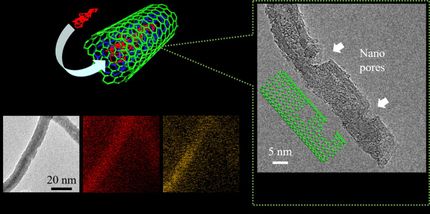From plastics to silicon to nanotubes?
Researchers figure out how to 'grow' carbon nanotubes with specific atomic structures
Move over, silicon. In a breakthrough in the quest for the next generation of computers and materials, researchers at USC have solved a longstanding challenge with carbon nanotubes: how to actually build them with specific, predictable atomic structures.
"We are solving a fundamental problem of the carbon nanotube," said Chongwu Zhou, professor in the Ming Hsieh Department of Electrical Engineering at the USC Viterbi School of Engineering and corresponding author of the study published August 23 in the journal Nano Letters. "To be able to control the atomic structure, or chirality, of nanotubes has basically been our dream, a dream in the nanotube field."
If this is an age built on silicon, then the next one may be built on carbon nanotubes, which have shown promise in everything from optics to energy storage to touch screens. Not only are nanotubes transparent, but this research discovery on how to control the atomic structure of nanotubes will pave the way for computers that are smaller, faster and more energy efficient than those reliant on silicon transistors.
"We are now working on scale up the process," Zhou said. "Our method can revoutionize the field and significantly push forward the real applications of nanotube in many fields."
Until now, scientists were unable to "grow" carbon nanotubes with specific attributes — say metallic rather than semiconducting — instead getting mixed, random batches and then sorting them. The sorting process also shortened the nanotubes significantly, making the material less practical for many applications.
For more than three years, the USC team has been working on the idea of using these short sorted nanotubes as "seeds" to grow longer nanotubes, extending them at high temperatures to get the desired atomic structure.
A paper last year by the same team in Nature Communications outlined the technique, and in the current Nano Letters paper, the researchers report on their latest major success: identifying the "growth recipes" for building carbon nanotubes with specific atomic structures.
"We identify the mechanisms required for mass amplification of nanotubes," said co-lead author Jia Liu, a doctoral student in chemistry at the USC Dornsife College of Letters, Arts and Sciences, recalling the moment when, alone in a dark room, she finally saw the spectral data supporting their method. "It was my Eureka moment."
To understand nanotube growth behaviors allows us to produce larger amounts of nanotubes and better control that growth," she continued.
Each defined type of carbon nanotube has a frequency at which it expands and contracts. The researchers showed that the newly grown nanotubes had the same atomic structure by matching the Raman frequency.
"This is a very exciting field, and this was the most difficult problem," said co-lead author Bilu Liu, a postdoctoral research associate at the USC Viterbi School of Engineering. "I met Professor Zhou [senior author of the paper] at a conference and he said he wanted to tackle the challenge of controlling the atomic structure of nanotubes. That's what brought me to his lab, because it was the biggest challenge."
In addition, the study found that nanotubes with different structures also behave very differently during their growth, with some nanotube structures growing faster and others growing longer under certain conditions.
"Previously it was very difficult to control the chirality, or atomic structure, of nanotubes, particularly when using metal nanoparticles," Bilu Liu said. "The structures may look quite similar, but the properties are very different. In this paper we decode the atomic structure of nanotubes and show how to control precisely that atomic structure."
Most read news
Topics
Organizations
Other news from the department science
These products might interest you

NANOPHOX CS by Sympatec
Particle size analysis in the nano range: Analyzing high concentrations with ease
Reliable results without time-consuming sample preparation

Eclipse by Wyatt Technology
FFF-MALS system for separation and characterization of macromolecules and nanoparticles
The latest and most innovative FFF system designed for highest usability, robustness and data quality

DynaPro Plate Reader III by Wyatt Technology
Screening of biopharmaceuticals and proteins with high-throughput dynamic light scattering (DLS)
Efficiently characterize your sample quality and stability from lead discovery to quality control

Get the chemical industry in your inbox
By submitting this form you agree that LUMITOS AG will send you the newsletter(s) selected above by email. Your data will not be passed on to third parties. Your data will be stored and processed in accordance with our data protection regulations. LUMITOS may contact you by email for the purpose of advertising or market and opinion surveys. You can revoke your consent at any time without giving reasons to LUMITOS AG, Ernst-Augustin-Str. 2, 12489 Berlin, Germany or by e-mail at revoke@lumitos.com with effect for the future. In addition, each email contains a link to unsubscribe from the corresponding newsletter.




























































